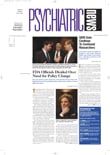Why do a few individuals with schizophrenia commit violent acts? The reasons are not clear, although certain risk factors, such as head injury and substance abuse, have been identified.
Now another possible explanation for such violence may have emerged from a study conducted by Israeli scientists and published in the March Journal of Clinical Psychiatry. Schizophrenia patients who commit violent acts appear to have difficulty in correctly evaluating the intensity of facial expressions.
Such an impairment may prompt them, during a conflict, to misinterpret other people's intentions and thus react aggressively rather than seek a peaceful solution.
Henry Silver, M.D., deputy director of the Sha'ar Menashe Mental Health Center in Hadera, Israel, and colleagues gave a battery of neurophysiological tests to 35 subjects with schizophrenia who had engaged in violence, 35 subjects with schizophrenia who had not, and 46 control subjects without a mental illness.
The tests evaluated executive function, attention, visual orientation, working memory, memory for faces and objects, motor function, ability to identify individual facial expressions, and ability to interpret the intensity of facial expressions correctly. (Previous research has indicated that identification of individual facial expressions and evaluation of facial-expression intensity are separate skills.)
Both groups of subjects with schizophrenia performed significantly worse than the control subjects did on all of the cognitive tests given. However, no significant differences were found between the violent schizophrenia group and the nonviolent schizophrenia group.
Both groups of schizophrenia subjects performed significantly worse than the controls on the test to identify individual facial expressions. Yet the violent schizophrenia group performed significantly better on this test than did the nonviolent schizophrenia group.
Regarding evaluation of facial-expression intensity, the nonviolent schizophrenia group performed as well as the healthy control group, while the violent schizophrenia group performed significantly worse than both.
Thus, it appears that violent schizophrenia patients may be better at identifying individual facial expressions than nonviolent schizophrenia patients are, yet worse than the latter at assessing facial-expression intensity.
And while Silver and his colleagues are not sure whether an inability to evaluate facial-expression intensity plays a role in violence by people with schizophrenia, they suspect that it might.
For example, if a violence-prone schizophrenia patient was in conflict with someone, he or she might be aroused by that person's expression of anger, yet incorrectly believe that the individual is more outraged than is really the case. As a result, he or she might react with aggression rather than seek a peaceful solution to the conflict.
Whether inability to assess facial-expression intensity correctly plays a role in schizophrenia violence, Silver believes that his group's study results have practical implications for schizophrenia patients and their families.
“Family sessions focusing on emotional communication may be useful,” he said in an interview. “One direction may be to teach family members to provide clear and multiple clues in their emotional communications with the ill relative.”
The types of facial expressions that Silver and his team used in their study were happy, sad, and neutral ones. They are currently assessing the ability of violent schizophrenia subjects and nonviolent schizophrenia subjects to identify and evaluate some other kinds of facial expressions, such as anger and fear.
The study was funded by the Israeli Ministry of Immigrant Absorption.
The study, “Schizophrenia Patients With a History of Severe Violence Differ From Nonviolent Schizophrenia Patients in Perception of Emotions but Not Cognitive Function,” is posted online at<www.psychiatrist.com/privatepdf/2005/v66n03/v66n0305.pdf>.▪
